HCS103 | Individual Field of Practice
VerifiedAdded on 2022/08/16
|8
|2301
|22
AI Summary
Contribute Materials
Your contribution can guide someone’s learning journey. Share your
documents today.
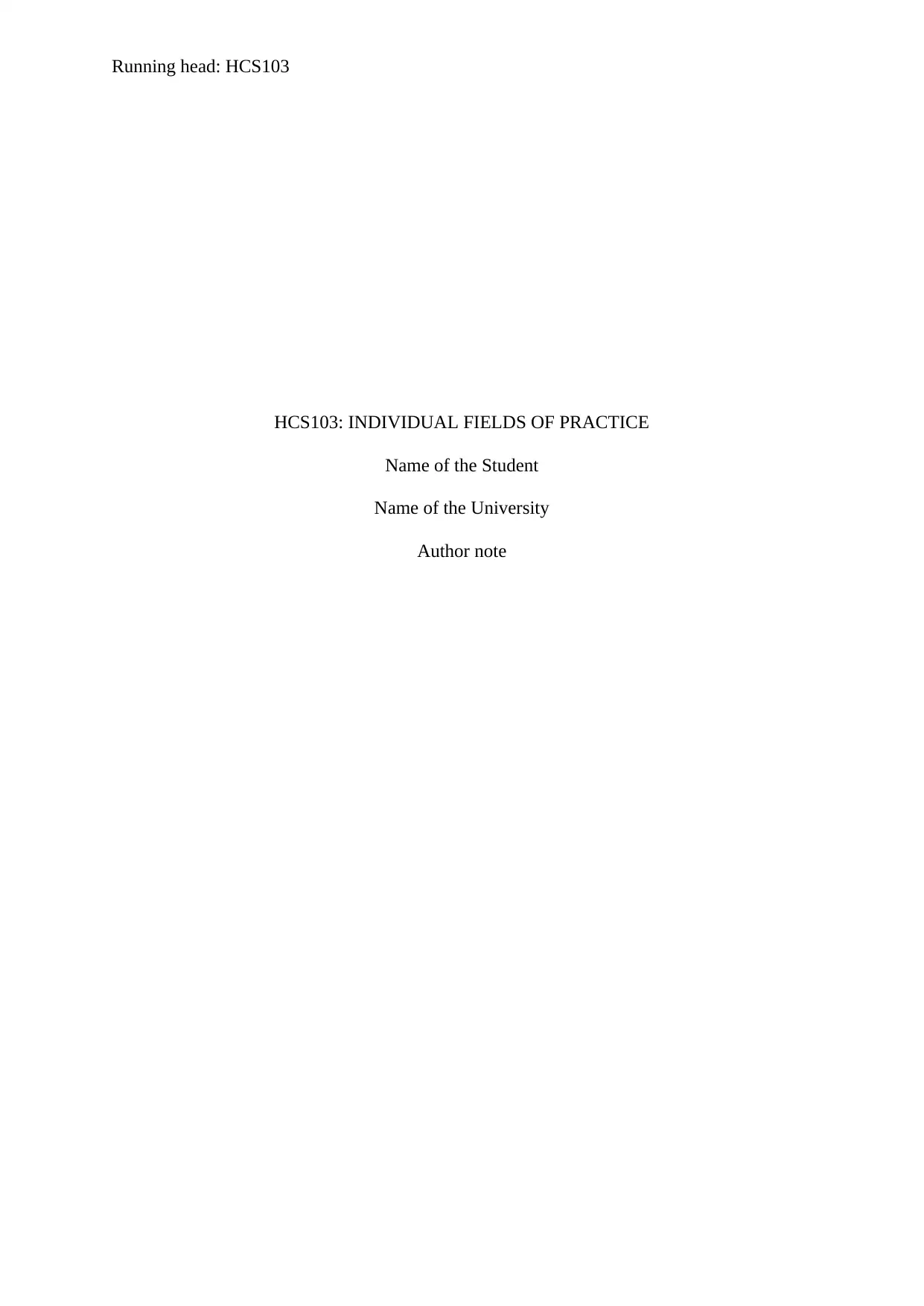
Running head: HCS103
HCS103: INDIVIDUAL FIELDS OF PRACTICE
Name of the Student
Name of the University
Author note
HCS103: INDIVIDUAL FIELDS OF PRACTICE
Name of the Student
Name of the University
Author note
Secure Best Marks with AI Grader
Need help grading? Try our AI Grader for instant feedback on your assignments.
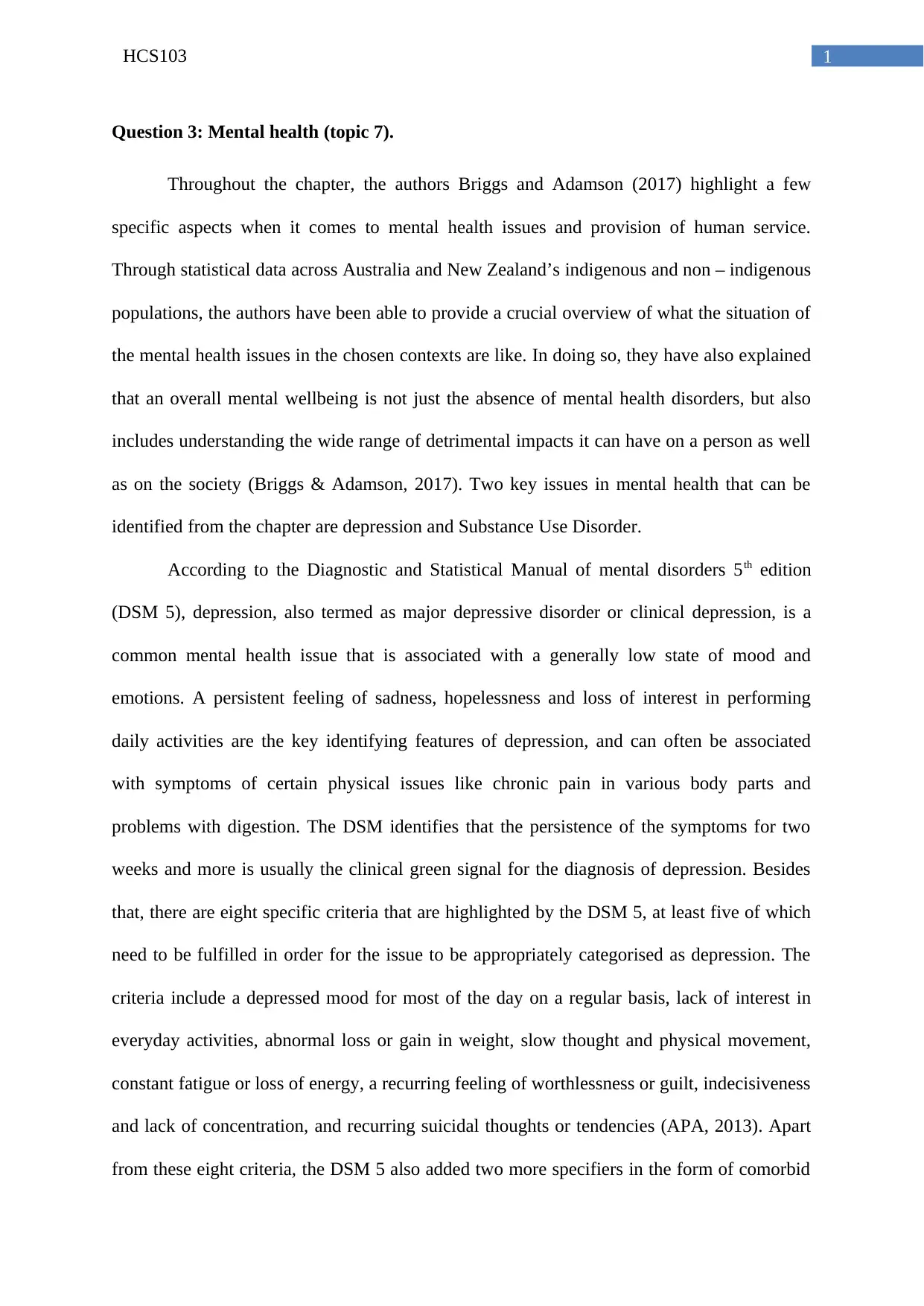
1HCS103
Question 3: Mental health (topic 7).
Throughout the chapter, the authors Briggs and Adamson (2017) highlight a few
specific aspects when it comes to mental health issues and provision of human service.
Through statistical data across Australia and New Zealand’s indigenous and non – indigenous
populations, the authors have been able to provide a crucial overview of what the situation of
the mental health issues in the chosen contexts are like. In doing so, they have also explained
that an overall mental wellbeing is not just the absence of mental health disorders, but also
includes understanding the wide range of detrimental impacts it can have on a person as well
as on the society (Briggs & Adamson, 2017). Two key issues in mental health that can be
identified from the chapter are depression and Substance Use Disorder.
According to the Diagnostic and Statistical Manual of mental disorders 5th edition
(DSM 5), depression, also termed as major depressive disorder or clinical depression, is a
common mental health issue that is associated with a generally low state of mood and
emotions. A persistent feeling of sadness, hopelessness and loss of interest in performing
daily activities are the key identifying features of depression, and can often be associated
with symptoms of certain physical issues like chronic pain in various body parts and
problems with digestion. The DSM identifies that the persistence of the symptoms for two
weeks and more is usually the clinical green signal for the diagnosis of depression. Besides
that, there are eight specific criteria that are highlighted by the DSM 5, at least five of which
need to be fulfilled in order for the issue to be appropriately categorised as depression. The
criteria include a depressed mood for most of the day on a regular basis, lack of interest in
everyday activities, abnormal loss or gain in weight, slow thought and physical movement,
constant fatigue or loss of energy, a recurring feeling of worthlessness or guilt, indecisiveness
and lack of concentration, and recurring suicidal thoughts or tendencies (APA, 2013). Apart
from these eight criteria, the DSM 5 also added two more specifiers in the form of comorbid
Question 3: Mental health (topic 7).
Throughout the chapter, the authors Briggs and Adamson (2017) highlight a few
specific aspects when it comes to mental health issues and provision of human service.
Through statistical data across Australia and New Zealand’s indigenous and non – indigenous
populations, the authors have been able to provide a crucial overview of what the situation of
the mental health issues in the chosen contexts are like. In doing so, they have also explained
that an overall mental wellbeing is not just the absence of mental health disorders, but also
includes understanding the wide range of detrimental impacts it can have on a person as well
as on the society (Briggs & Adamson, 2017). Two key issues in mental health that can be
identified from the chapter are depression and Substance Use Disorder.
According to the Diagnostic and Statistical Manual of mental disorders 5th edition
(DSM 5), depression, also termed as major depressive disorder or clinical depression, is a
common mental health issue that is associated with a generally low state of mood and
emotions. A persistent feeling of sadness, hopelessness and loss of interest in performing
daily activities are the key identifying features of depression, and can often be associated
with symptoms of certain physical issues like chronic pain in various body parts and
problems with digestion. The DSM identifies that the persistence of the symptoms for two
weeks and more is usually the clinical green signal for the diagnosis of depression. Besides
that, there are eight specific criteria that are highlighted by the DSM 5, at least five of which
need to be fulfilled in order for the issue to be appropriately categorised as depression. The
criteria include a depressed mood for most of the day on a regular basis, lack of interest in
everyday activities, abnormal loss or gain in weight, slow thought and physical movement,
constant fatigue or loss of energy, a recurring feeling of worthlessness or guilt, indecisiveness
and lack of concentration, and recurring suicidal thoughts or tendencies (APA, 2013). Apart
from these eight criteria, the DSM 5 also added two more specifiers in the form of comorbid
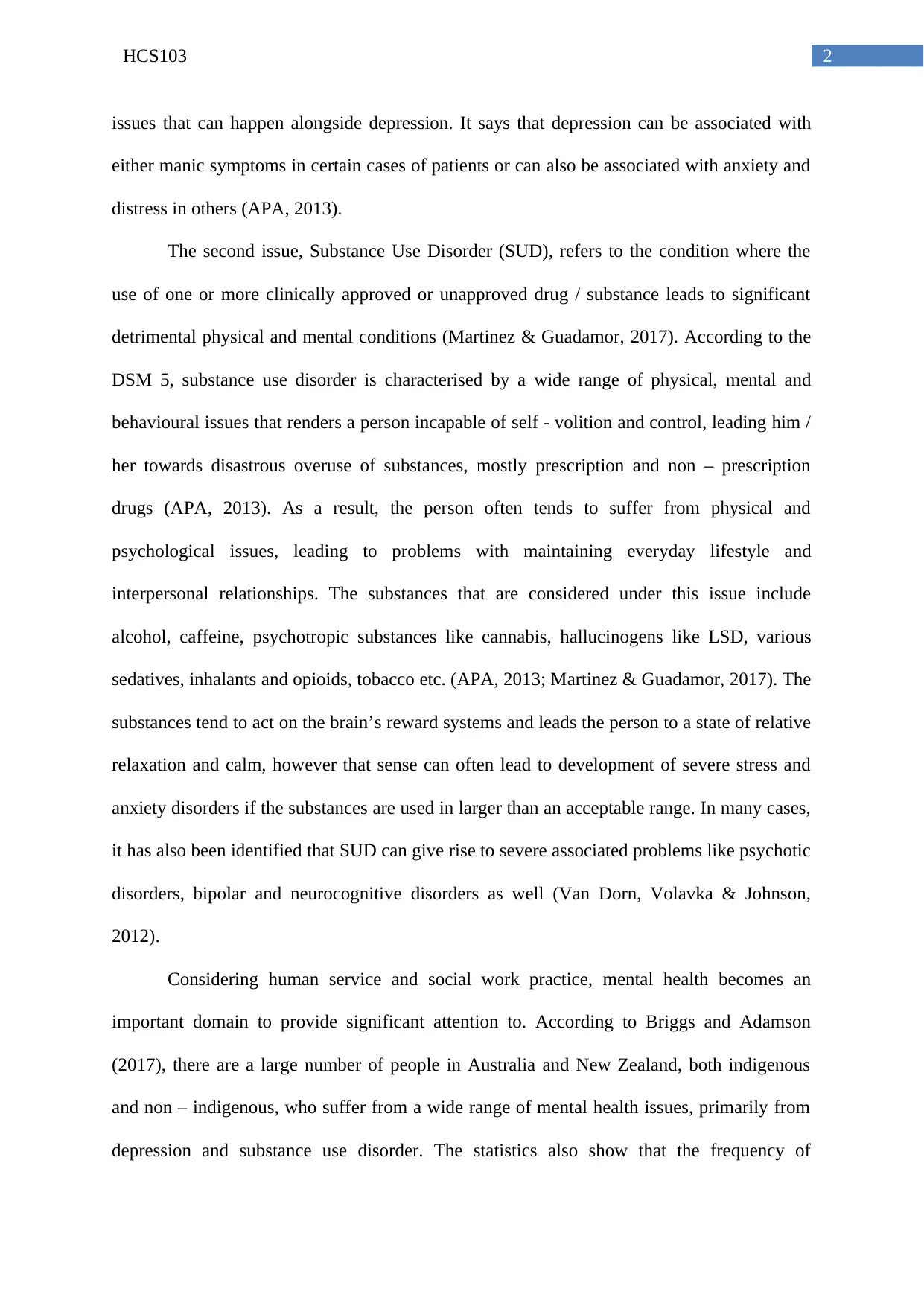
2HCS103
issues that can happen alongside depression. It says that depression can be associated with
either manic symptoms in certain cases of patients or can also be associated with anxiety and
distress in others (APA, 2013).
The second issue, Substance Use Disorder (SUD), refers to the condition where the
use of one or more clinically approved or unapproved drug / substance leads to significant
detrimental physical and mental conditions (Martinez & Guadamor, 2017). According to the
DSM 5, substance use disorder is characterised by a wide range of physical, mental and
behavioural issues that renders a person incapable of self - volition and control, leading him /
her towards disastrous overuse of substances, mostly prescription and non – prescription
drugs (APA, 2013). As a result, the person often tends to suffer from physical and
psychological issues, leading to problems with maintaining everyday lifestyle and
interpersonal relationships. The substances that are considered under this issue include
alcohol, caffeine, psychotropic substances like cannabis, hallucinogens like LSD, various
sedatives, inhalants and opioids, tobacco etc. (APA, 2013; Martinez & Guadamor, 2017). The
substances tend to act on the brain’s reward systems and leads the person to a state of relative
relaxation and calm, however that sense can often lead to development of severe stress and
anxiety disorders if the substances are used in larger than an acceptable range. In many cases,
it has also been identified that SUD can give rise to severe associated problems like psychotic
disorders, bipolar and neurocognitive disorders as well (Van Dorn, Volavka & Johnson,
2012).
Considering human service and social work practice, mental health becomes an
important domain to provide significant attention to. According to Briggs and Adamson
(2017), there are a large number of people in Australia and New Zealand, both indigenous
and non – indigenous, who suffer from a wide range of mental health issues, primarily from
depression and substance use disorder. The statistics also show that the frequency of
issues that can happen alongside depression. It says that depression can be associated with
either manic symptoms in certain cases of patients or can also be associated with anxiety and
distress in others (APA, 2013).
The second issue, Substance Use Disorder (SUD), refers to the condition where the
use of one or more clinically approved or unapproved drug / substance leads to significant
detrimental physical and mental conditions (Martinez & Guadamor, 2017). According to the
DSM 5, substance use disorder is characterised by a wide range of physical, mental and
behavioural issues that renders a person incapable of self - volition and control, leading him /
her towards disastrous overuse of substances, mostly prescription and non – prescription
drugs (APA, 2013). As a result, the person often tends to suffer from physical and
psychological issues, leading to problems with maintaining everyday lifestyle and
interpersonal relationships. The substances that are considered under this issue include
alcohol, caffeine, psychotropic substances like cannabis, hallucinogens like LSD, various
sedatives, inhalants and opioids, tobacco etc. (APA, 2013; Martinez & Guadamor, 2017). The
substances tend to act on the brain’s reward systems and leads the person to a state of relative
relaxation and calm, however that sense can often lead to development of severe stress and
anxiety disorders if the substances are used in larger than an acceptable range. In many cases,
it has also been identified that SUD can give rise to severe associated problems like psychotic
disorders, bipolar and neurocognitive disorders as well (Van Dorn, Volavka & Johnson,
2012).
Considering human service and social work practice, mental health becomes an
important domain to provide significant attention to. According to Briggs and Adamson
(2017), there are a large number of people in Australia and New Zealand, both indigenous
and non – indigenous, who suffer from a wide range of mental health issues, primarily from
depression and substance use disorder. The statistics also show that the frequency of
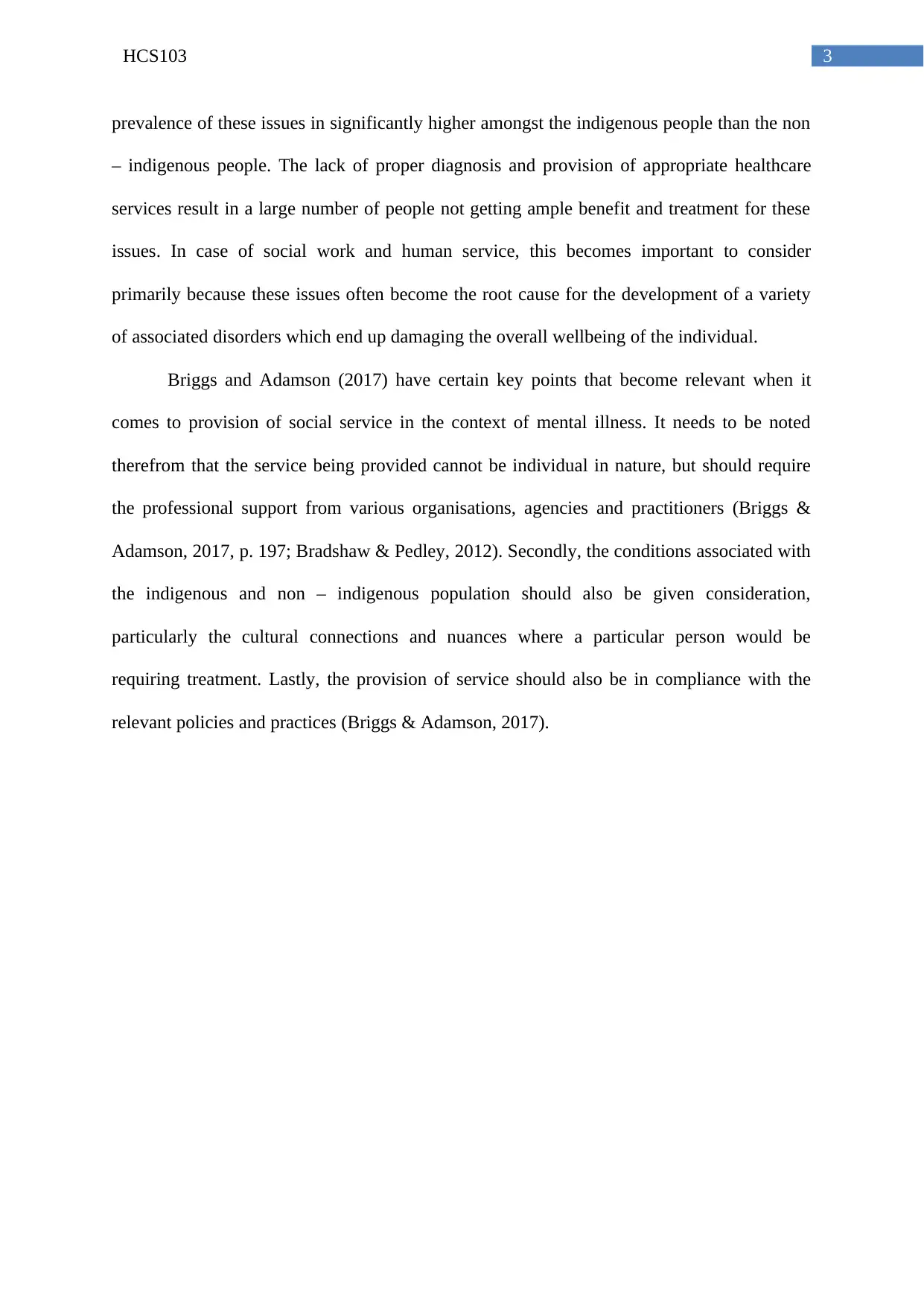
3HCS103
prevalence of these issues in significantly higher amongst the indigenous people than the non
– indigenous people. The lack of proper diagnosis and provision of appropriate healthcare
services result in a large number of people not getting ample benefit and treatment for these
issues. In case of social work and human service, this becomes important to consider
primarily because these issues often become the root cause for the development of a variety
of associated disorders which end up damaging the overall wellbeing of the individual.
Briggs and Adamson (2017) have certain key points that become relevant when it
comes to provision of social service in the context of mental illness. It needs to be noted
therefrom that the service being provided cannot be individual in nature, but should require
the professional support from various organisations, agencies and practitioners (Briggs &
Adamson, 2017, p. 197; Bradshaw & Pedley, 2012). Secondly, the conditions associated with
the indigenous and non – indigenous population should also be given consideration,
particularly the cultural connections and nuances where a particular person would be
requiring treatment. Lastly, the provision of service should also be in compliance with the
relevant policies and practices (Briggs & Adamson, 2017).
prevalence of these issues in significantly higher amongst the indigenous people than the non
– indigenous people. The lack of proper diagnosis and provision of appropriate healthcare
services result in a large number of people not getting ample benefit and treatment for these
issues. In case of social work and human service, this becomes important to consider
primarily because these issues often become the root cause for the development of a variety
of associated disorders which end up damaging the overall wellbeing of the individual.
Briggs and Adamson (2017) have certain key points that become relevant when it
comes to provision of social service in the context of mental illness. It needs to be noted
therefrom that the service being provided cannot be individual in nature, but should require
the professional support from various organisations, agencies and practitioners (Briggs &
Adamson, 2017, p. 197; Bradshaw & Pedley, 2012). Secondly, the conditions associated with
the indigenous and non – indigenous population should also be given consideration,
particularly the cultural connections and nuances where a particular person would be
requiring treatment. Lastly, the provision of service should also be in compliance with the
relevant policies and practices (Briggs & Adamson, 2017).
Secure Best Marks with AI Grader
Need help grading? Try our AI Grader for instant feedback on your assignments.
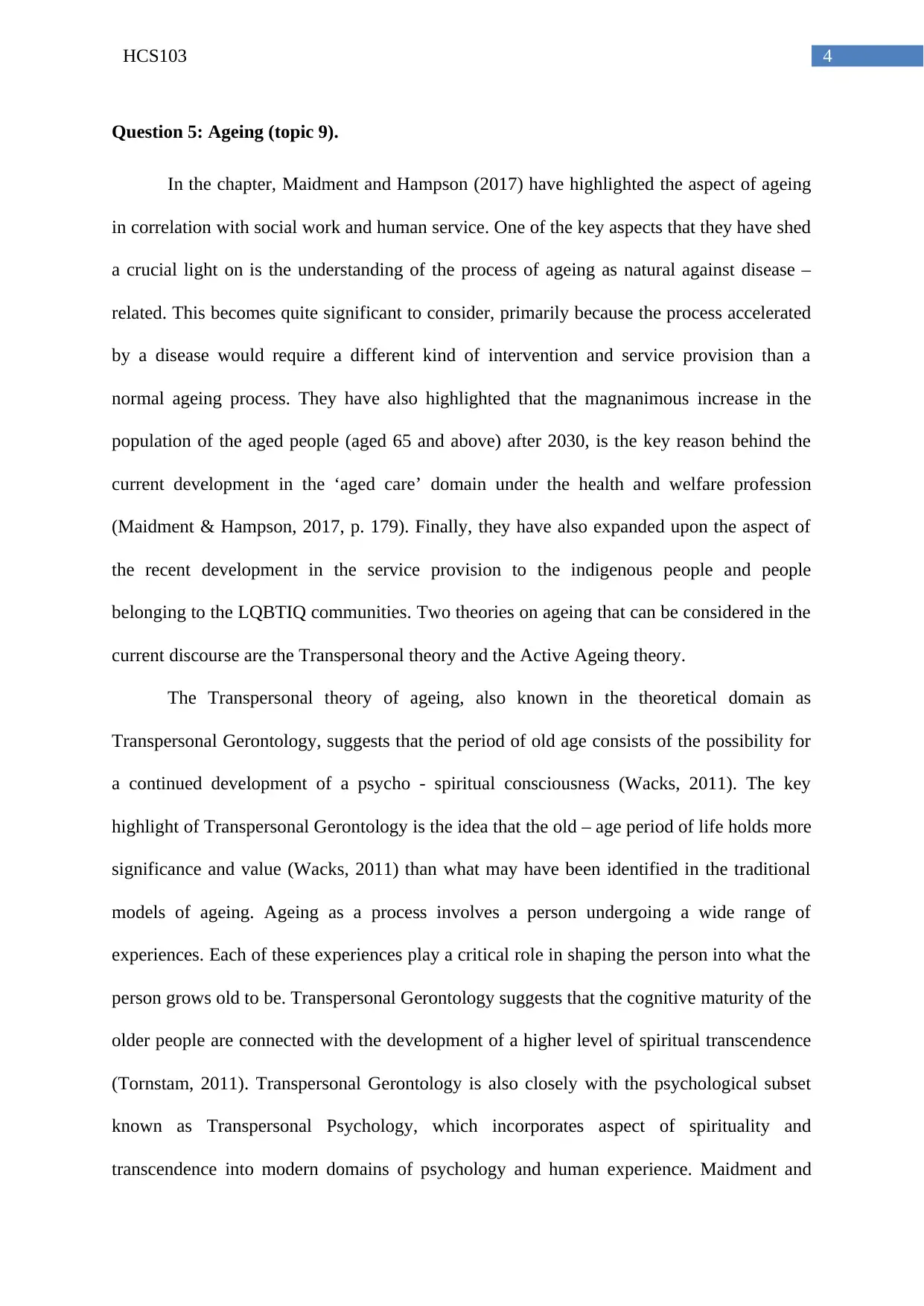
4HCS103
Question 5: Ageing (topic 9).
In the chapter, Maidment and Hampson (2017) have highlighted the aspect of ageing
in correlation with social work and human service. One of the key aspects that they have shed
a crucial light on is the understanding of the process of ageing as natural against disease –
related. This becomes quite significant to consider, primarily because the process accelerated
by a disease would require a different kind of intervention and service provision than a
normal ageing process. They have also highlighted that the magnanimous increase in the
population of the aged people (aged 65 and above) after 2030, is the key reason behind the
current development in the ‘aged care’ domain under the health and welfare profession
(Maidment & Hampson, 2017, p. 179). Finally, they have also expanded upon the aspect of
the recent development in the service provision to the indigenous people and people
belonging to the LQBTIQ communities. Two theories on ageing that can be considered in the
current discourse are the Transpersonal theory and the Active Ageing theory.
The Transpersonal theory of ageing, also known in the theoretical domain as
Transpersonal Gerontology, suggests that the period of old age consists of the possibility for
a continued development of a psycho - spiritual consciousness (Wacks, 2011). The key
highlight of Transpersonal Gerontology is the idea that the old – age period of life holds more
significance and value (Wacks, 2011) than what may have been identified in the traditional
models of ageing. Ageing as a process involves a person undergoing a wide range of
experiences. Each of these experiences play a critical role in shaping the person into what the
person grows old to be. Transpersonal Gerontology suggests that the cognitive maturity of the
older people are connected with the development of a higher level of spiritual transcendence
(Tornstam, 2011). Transpersonal Gerontology is also closely with the psychological subset
known as Transpersonal Psychology, which incorporates aspect of spirituality and
transcendence into modern domains of psychology and human experience. Maidment and
Question 5: Ageing (topic 9).
In the chapter, Maidment and Hampson (2017) have highlighted the aspect of ageing
in correlation with social work and human service. One of the key aspects that they have shed
a crucial light on is the understanding of the process of ageing as natural against disease –
related. This becomes quite significant to consider, primarily because the process accelerated
by a disease would require a different kind of intervention and service provision than a
normal ageing process. They have also highlighted that the magnanimous increase in the
population of the aged people (aged 65 and above) after 2030, is the key reason behind the
current development in the ‘aged care’ domain under the health and welfare profession
(Maidment & Hampson, 2017, p. 179). Finally, they have also expanded upon the aspect of
the recent development in the service provision to the indigenous people and people
belonging to the LQBTIQ communities. Two theories on ageing that can be considered in the
current discourse are the Transpersonal theory and the Active Ageing theory.
The Transpersonal theory of ageing, also known in the theoretical domain as
Transpersonal Gerontology, suggests that the period of old age consists of the possibility for
a continued development of a psycho - spiritual consciousness (Wacks, 2011). The key
highlight of Transpersonal Gerontology is the idea that the old – age period of life holds more
significance and value (Wacks, 2011) than what may have been identified in the traditional
models of ageing. Ageing as a process involves a person undergoing a wide range of
experiences. Each of these experiences play a critical role in shaping the person into what the
person grows old to be. Transpersonal Gerontology suggests that the cognitive maturity of the
older people are connected with the development of a higher level of spiritual transcendence
(Tornstam, 2011). Transpersonal Gerontology is also closely with the psychological subset
known as Transpersonal Psychology, which incorporates aspect of spirituality and
transcendence into modern domains of psychology and human experience. Maidment and
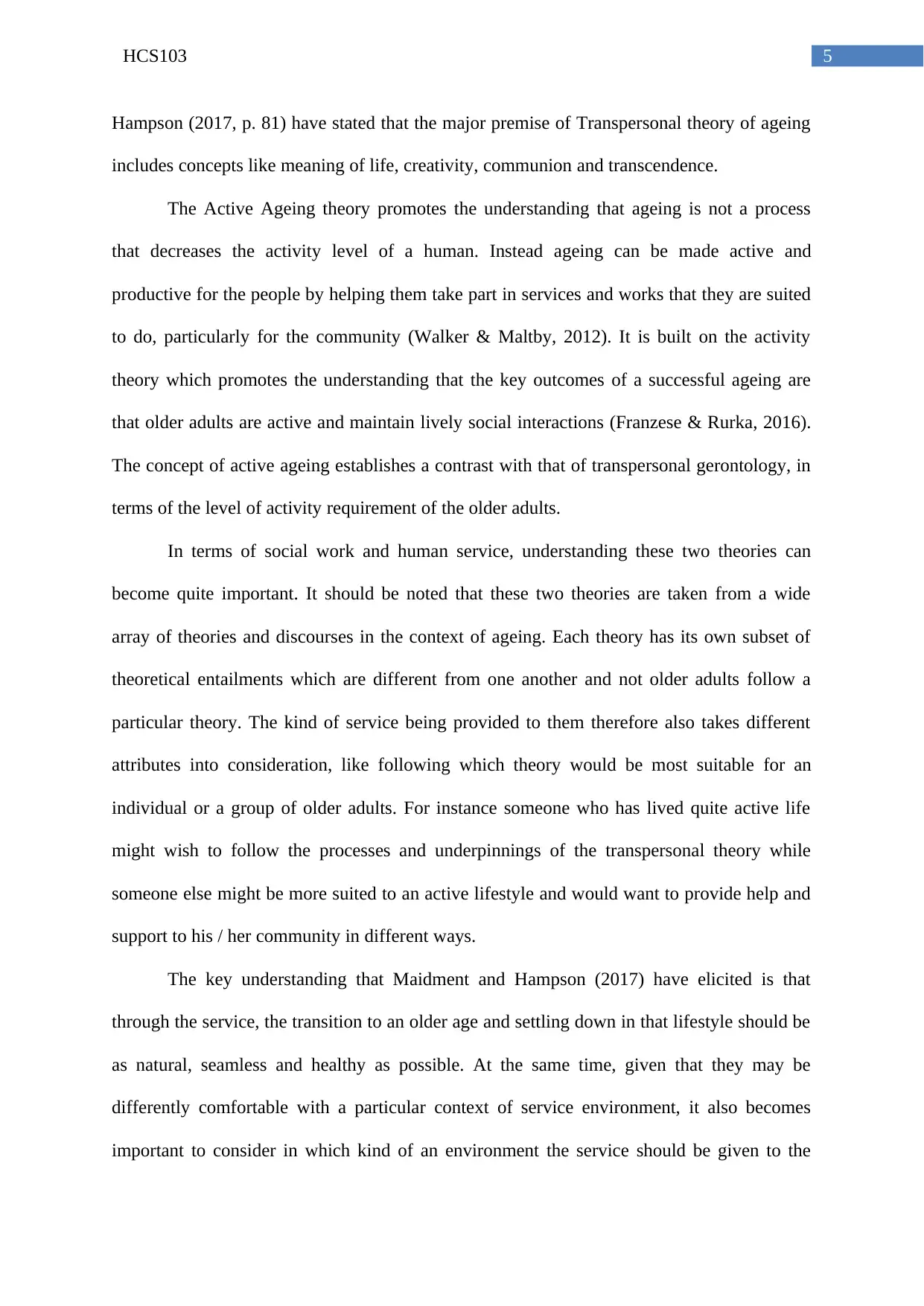
5HCS103
Hampson (2017, p. 81) have stated that the major premise of Transpersonal theory of ageing
includes concepts like meaning of life, creativity, communion and transcendence.
The Active Ageing theory promotes the understanding that ageing is not a process
that decreases the activity level of a human. Instead ageing can be made active and
productive for the people by helping them take part in services and works that they are suited
to do, particularly for the community (Walker & Maltby, 2012). It is built on the activity
theory which promotes the understanding that the key outcomes of a successful ageing are
that older adults are active and maintain lively social interactions (Franzese & Rurka, 2016).
The concept of active ageing establishes a contrast with that of transpersonal gerontology, in
terms of the level of activity requirement of the older adults.
In terms of social work and human service, understanding these two theories can
become quite important. It should be noted that these two theories are taken from a wide
array of theories and discourses in the context of ageing. Each theory has its own subset of
theoretical entailments which are different from one another and not older adults follow a
particular theory. The kind of service being provided to them therefore also takes different
attributes into consideration, like following which theory would be most suitable for an
individual or a group of older adults. For instance someone who has lived quite active life
might wish to follow the processes and underpinnings of the transpersonal theory while
someone else might be more suited to an active lifestyle and would want to provide help and
support to his / her community in different ways.
The key understanding that Maidment and Hampson (2017) have elicited is that
through the service, the transition to an older age and settling down in that lifestyle should be
as natural, seamless and healthy as possible. At the same time, given that they may be
differently comfortable with a particular context of service environment, it also becomes
important to consider in which kind of an environment the service should be given to the
Hampson (2017, p. 81) have stated that the major premise of Transpersonal theory of ageing
includes concepts like meaning of life, creativity, communion and transcendence.
The Active Ageing theory promotes the understanding that ageing is not a process
that decreases the activity level of a human. Instead ageing can be made active and
productive for the people by helping them take part in services and works that they are suited
to do, particularly for the community (Walker & Maltby, 2012). It is built on the activity
theory which promotes the understanding that the key outcomes of a successful ageing are
that older adults are active and maintain lively social interactions (Franzese & Rurka, 2016).
The concept of active ageing establishes a contrast with that of transpersonal gerontology, in
terms of the level of activity requirement of the older adults.
In terms of social work and human service, understanding these two theories can
become quite important. It should be noted that these two theories are taken from a wide
array of theories and discourses in the context of ageing. Each theory has its own subset of
theoretical entailments which are different from one another and not older adults follow a
particular theory. The kind of service being provided to them therefore also takes different
attributes into consideration, like following which theory would be most suitable for an
individual or a group of older adults. For instance someone who has lived quite active life
might wish to follow the processes and underpinnings of the transpersonal theory while
someone else might be more suited to an active lifestyle and would want to provide help and
support to his / her community in different ways.
The key understanding that Maidment and Hampson (2017) have elicited is that
through the service, the transition to an older age and settling down in that lifestyle should be
as natural, seamless and healthy as possible. At the same time, given that they may be
differently comfortable with a particular context of service environment, it also becomes
important to consider in which kind of an environment the service should be given to the
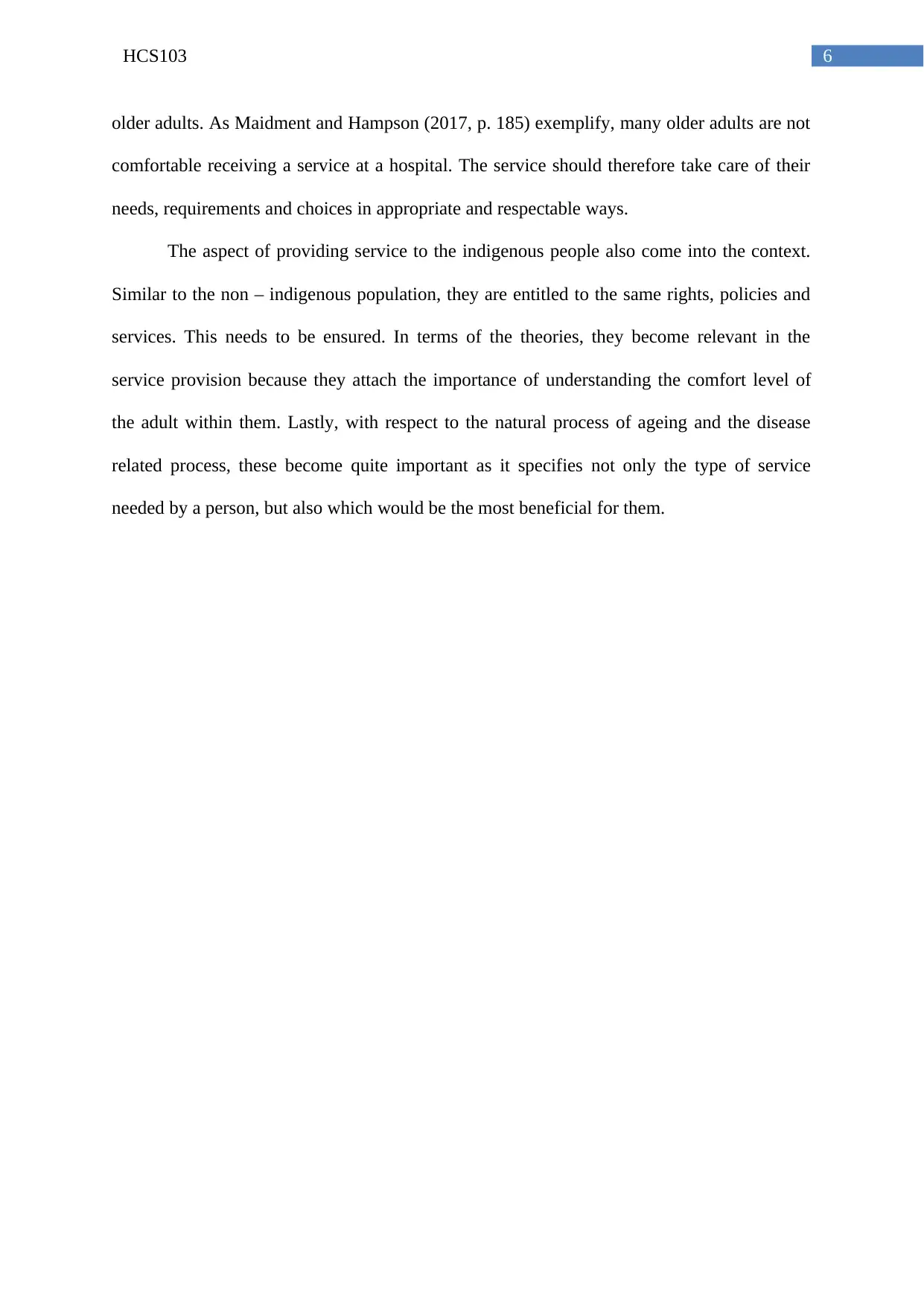
6HCS103
older adults. As Maidment and Hampson (2017, p. 185) exemplify, many older adults are not
comfortable receiving a service at a hospital. The service should therefore take care of their
needs, requirements and choices in appropriate and respectable ways.
The aspect of providing service to the indigenous people also come into the context.
Similar to the non – indigenous population, they are entitled to the same rights, policies and
services. This needs to be ensured. In terms of the theories, they become relevant in the
service provision because they attach the importance of understanding the comfort level of
the adult within them. Lastly, with respect to the natural process of ageing and the disease
related process, these become quite important as it specifies not only the type of service
needed by a person, but also which would be the most beneficial for them.
older adults. As Maidment and Hampson (2017, p. 185) exemplify, many older adults are not
comfortable receiving a service at a hospital. The service should therefore take care of their
needs, requirements and choices in appropriate and respectable ways.
The aspect of providing service to the indigenous people also come into the context.
Similar to the non – indigenous population, they are entitled to the same rights, policies and
services. This needs to be ensured. In terms of the theories, they become relevant in the
service provision because they attach the importance of understanding the comfort level of
the adult within them. Lastly, with respect to the natural process of ageing and the disease
related process, these become quite important as it specifies not only the type of service
needed by a person, but also which would be the most beneficial for them.
Paraphrase This Document
Need a fresh take? Get an instant paraphrase of this document with our AI Paraphraser
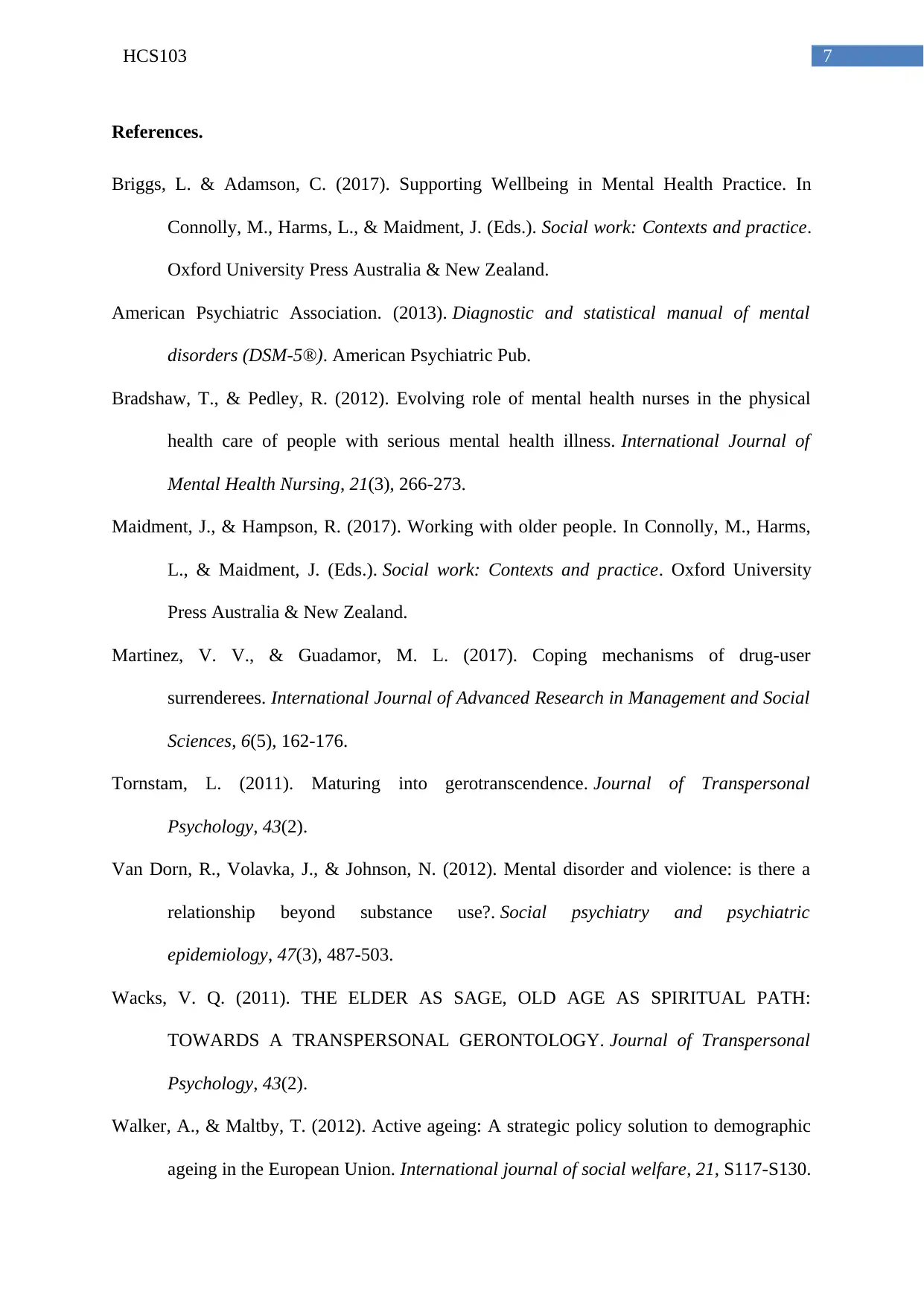
7HCS103
References.
Briggs, L. & Adamson, C. (2017). Supporting Wellbeing in Mental Health Practice. In
Connolly, M., Harms, L., & Maidment, J. (Eds.). Social work: Contexts and practice.
Oxford University Press Australia & New Zealand.
American Psychiatric Association. (2013). Diagnostic and statistical manual of mental
disorders (DSM-5®). American Psychiatric Pub.
Bradshaw, T., & Pedley, R. (2012). Evolving role of mental health nurses in the physical
health care of people with serious mental health illness. International Journal of
Mental Health Nursing, 21(3), 266-273.
Maidment, J., & Hampson, R. (2017). Working with older people. In Connolly, M., Harms,
L., & Maidment, J. (Eds.). Social work: Contexts and practice. Oxford University
Press Australia & New Zealand.
Martinez, V. V., & Guadamor, M. L. (2017). Coping mechanisms of drug-user
surrenderees. International Journal of Advanced Research in Management and Social
Sciences, 6(5), 162-176.
Tornstam, L. (2011). Maturing into gerotranscendence. Journal of Transpersonal
Psychology, 43(2).
Van Dorn, R., Volavka, J., & Johnson, N. (2012). Mental disorder and violence: is there a
relationship beyond substance use?. Social psychiatry and psychiatric
epidemiology, 47(3), 487-503.
Wacks, V. Q. (2011). THE ELDER AS SAGE, OLD AGE AS SPIRITUAL PATH:
TOWARDS A TRANSPERSONAL GERONTOLOGY. Journal of Transpersonal
Psychology, 43(2).
Walker, A., & Maltby, T. (2012). Active ageing: A strategic policy solution to demographic
ageing in the European Union. International journal of social welfare, 21, S117-S130.
References.
Briggs, L. & Adamson, C. (2017). Supporting Wellbeing in Mental Health Practice. In
Connolly, M., Harms, L., & Maidment, J. (Eds.). Social work: Contexts and practice.
Oxford University Press Australia & New Zealand.
American Psychiatric Association. (2013). Diagnostic and statistical manual of mental
disorders (DSM-5®). American Psychiatric Pub.
Bradshaw, T., & Pedley, R. (2012). Evolving role of mental health nurses in the physical
health care of people with serious mental health illness. International Journal of
Mental Health Nursing, 21(3), 266-273.
Maidment, J., & Hampson, R. (2017). Working with older people. In Connolly, M., Harms,
L., & Maidment, J. (Eds.). Social work: Contexts and practice. Oxford University
Press Australia & New Zealand.
Martinez, V. V., & Guadamor, M. L. (2017). Coping mechanisms of drug-user
surrenderees. International Journal of Advanced Research in Management and Social
Sciences, 6(5), 162-176.
Tornstam, L. (2011). Maturing into gerotranscendence. Journal of Transpersonal
Psychology, 43(2).
Van Dorn, R., Volavka, J., & Johnson, N. (2012). Mental disorder and violence: is there a
relationship beyond substance use?. Social psychiatry and psychiatric
epidemiology, 47(3), 487-503.
Wacks, V. Q. (2011). THE ELDER AS SAGE, OLD AGE AS SPIRITUAL PATH:
TOWARDS A TRANSPERSONAL GERONTOLOGY. Journal of Transpersonal
Psychology, 43(2).
Walker, A., & Maltby, T. (2012). Active ageing: A strategic policy solution to demographic
ageing in the European Union. International journal of social welfare, 21, S117-S130.
1 out of 8
Related Documents
Your All-in-One AI-Powered Toolkit for Academic Success.
+13062052269
info@desklib.com
Available 24*7 on WhatsApp / Email
![[object Object]](/_next/static/media/star-bottom.7253800d.svg)
Unlock your academic potential
© 2024 | Zucol Services PVT LTD | All rights reserved.





